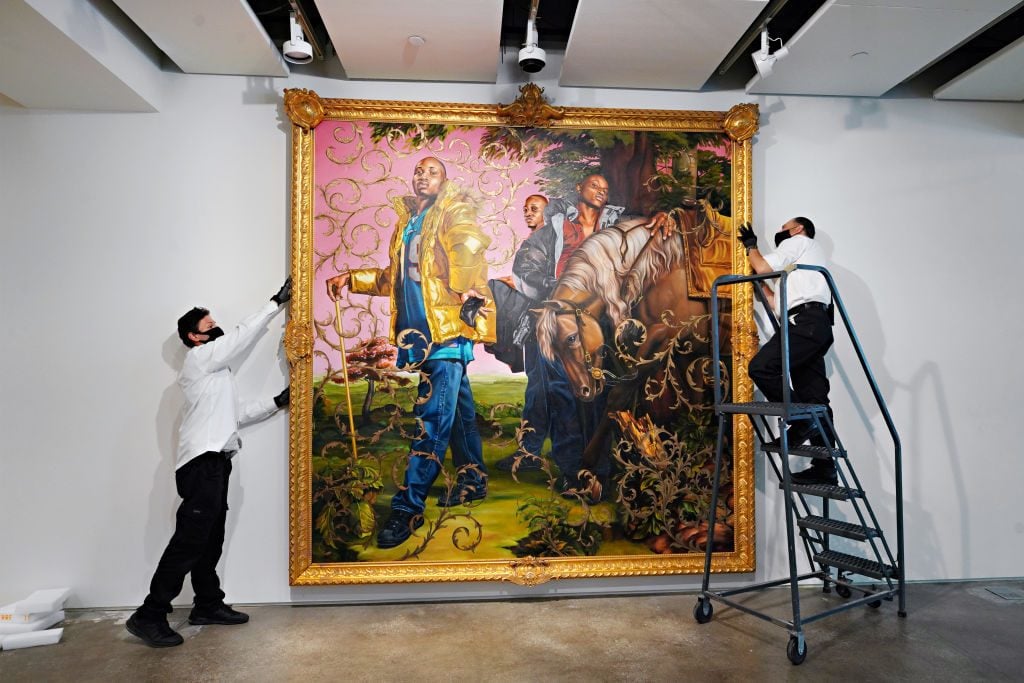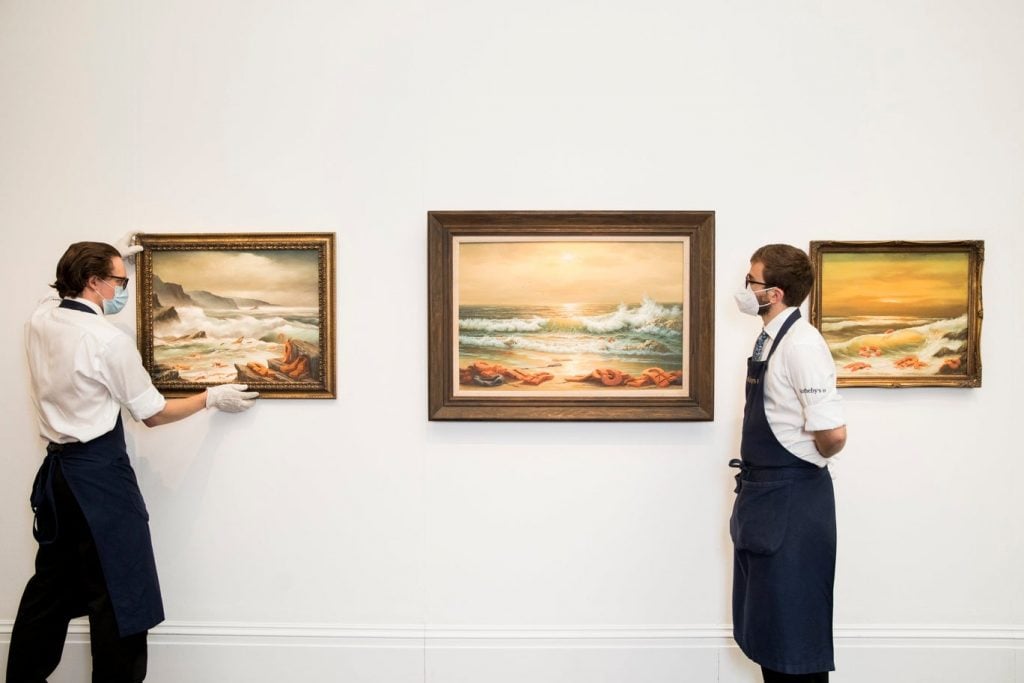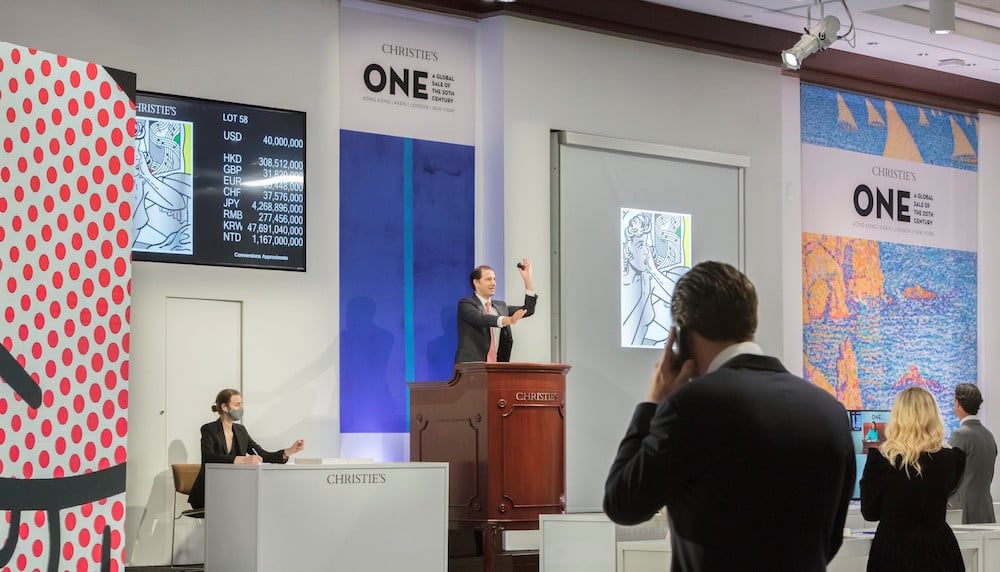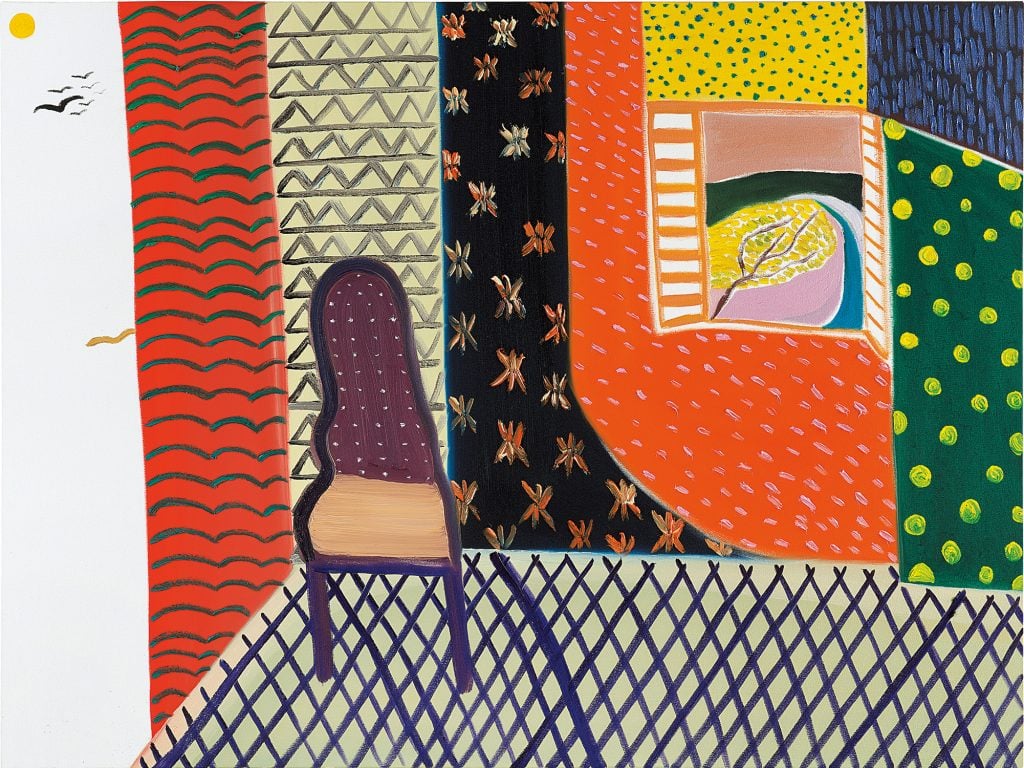Auctions
‘Business as Usual Went Right Out the Window’: How Lockdown Forced Auction Houses Into the Future—for Good
Despite suffering a nosedive in revenue, here’s how the biggest auction houses in the world are evolving to survive.

Despite suffering a nosedive in revenue, here’s how the biggest auction houses in the world are evolving to survive.

Eileen Kinsella

A version of this story first appeared in the fall 2020 Artnet Intelligence Report, which you can download in full for free here.
When auctioneer Oliver Barker stepped into the Sotheby’s London salesroom on June 29 to helm its first-ever global livestreamed auction, the whole art world was watching. The evening would show not only whether Sotheby’s could pull off a major sale in the social distancing era but also whether the predictions were true that the art market was heading into a painful, prolonged period of correction.
Total Sotheby’s art sales for the three and half months between mid-March and that big night had plummeted a stomach-churning 90 percent year over year. In response, management had been brutally cutting costs, eliminating altruistic programs like the Sotheby’s Prize, laying off dozens of workers, furloughing hundreds more, and subjecting the expenses of remaining employees to forensic analysis.
But all that drama was happening backstage. Ahead of the marquee sale, Sotheby’s put enormous energy—and cash—into creating a production that looked seamless and polished in front of the camera. It enlisted Chrome, a production company that specializes in covering extreme sports, to optimize its salesroom layouts and audio systems in London, New York, and Hong Kong for broadcast capabilities. It hired stylists to dress Sotheby’s specialists so that their outfits popped against the color scheme of each city’s unique “set.”

Art handlers prepare Kehinde Wiley’s La Roi A La Chasse II at Sotheby’s New York. Photo by Cindy Ord/Getty Images).
By the end of the four-and-a-half-hour marathon sale, Sotheby’s had managed to pull in $363.2 million—including $84.6 million for a triptych by Francis Bacon. It was almost 5 a.m. in London when the cameras turned off and Barker left the rostrum. On three continents, staff descended from their raised platforms, stepped over tangles of black wires, dodged the AV crew members, and breathed a heavy sigh of relief. The auction had come out smack in the middle of well-managed presale expectations.
This round of summer sales—rescheduled from their traditional May dates—was essential for the optics of the market, if not a cure-all for its bottom line. The Big Three auction houses (Sotheby’s, Phillips, and Christie’s) generated a combined $825 million. That was enough to reassure a jittery sector—but it was a far cry from the $2 billion made during last year’s marquee May auctions. (The success was also extremely well orchestrated: both Sotheby’s and Christie’s lined up guarantees for at least half the works in their sales.) As Christie’s CEO Guillaume Cerutti hopefully put it, one of the biggest results of his major summer auction was “to give confidence to our clients.”
Confidence, of course, was key at that critical moment—these were the first sales of a new era. Now comes the hard part: adapting for the long haul.
At warp speed, the lockdown era has transformed the traditional auction business. From conducting socially distanced outdoor appraisals to navigating shipping hurdles to holding appointment-only, mask-mandatory sale previews in cavernous gallery spaces, the virus forced venerable houses to make drastic changes almost overnight.
“In all my years in the art market, there has never been an external event that forced such immediate change,” said David Norman, Phillips chairman of the Americas. “Business as usual went right out the window.”

Banksy’s Mediterranean Sea View (2017) at Sotheby’s. (Photo by Tristan Fewings/Getty Images for Sotheby’s)
Art-market veterans said the sector has never faced a challenge on the scale of this one—not when Japanese buyers disappeared from the high-flying Impressionist market in the 1990s, not during the first Gulf War, not in the wake of the September 11 terrorist attacks, and not in the aftermath of the 2008 global financial crisis.
Some of the immediate changes made as a result—like the permanent elimination of almost all splashy and expensive catalogues, the migration of sales online, and the collapsing of departments and categories—were in fact a long time coming. Other, less predictable ones, like the deep cutbacks on entertainment, dining, and travel, as well as the significant layoffs, will change the way the business functions for at least the foreseeable future, for better or worse.
Here is a rundown of the most significant ways the events of 2020 will change the brick-and-mortar auction industry.
Unable for months on end to hold sales safely in a physical space, auction houses rushed to bring them onto the web. In the first half of the year, Christie’s, Sotheby’s, and Phillips held more than 131 online sales, according to the Artnet Price Database—more than twice as many as in the equivalent period in 2019. Together, they brought in $186.4 million, a nearly 475 percent increase over the previous year.
“We’re in an express lane that put us ahead three to five years,” said Alex Rotter, Christie’s chairman of 20th and 21st-century art. “Under normal circumstances, it would have taken a long time to get here, and there wouldn’t have been this urgency to have this exploration, or take this global view.”
Buyers seem receptive. Even in the early days of the shutdown, clients were bidding actively on lower-priced art, as well as on more expensive watches, sneakers, and jewelry. Since the beginning of lockdown, Phillips said, it has seen a 140 percent increase in the creation of online accounts and a nearly 50 percent increase in web traffic. (The shift benefited online-only auction houses as well: Artnet’s own auction platform saw a nearly 50 percent increase in new buyers, and total sales have been up monthly since March year over year.)

Auctioneer Adrien Meyer at Christie’s Rockefeller Center salesroom during the New York portion of the ONE sale on July 10. Image courtesy Christie’s
According to experts, these results indicated that many formerly live sales—those once commonly held in nearly empty rooms in the middle of the day—will migrate online for good. Furthermore, collectors’ attitudes about buying art online above a certain dollar value are likely to continue evolving.
In March, the average artwork sold online at one of the Big Three houses cost $24,027. By June, that figure had risen almost 15 percent, to $27,089. “There were more collectors who bid this season without seeing the work in person who had said they would never do that than I would have ever expected,” said David Galperin, the head of the Sotheby’s contemporary art evening sale in New York.
Even tentpole evening sales will likely retain some online component after social-distancing restrictions are lifted. “It’s too convenient,” Phillips deputy chairman Jean-Paul Engelen explained. He noted that one lot in a recent Phillips sale had 110 registered bidders, and specialists’ having to field all that activity over the phone would have occupied “almost half our company.”
As the regular auction schedule fell into disarray, the stock market soared, and art fairs—often a competitor with auction houses for high-dollar works—fell like dominoes, buyers shifted their focus to private sales via auction-house specialists. It’s a pattern that is likely to continue as the traditional art calendar remains up in the air, according to some observers.
“People have made a lot of money in the past six months, and that money is looking for a place to live,” said attorney Thomas Danziger, who negotiates deals on behalf of clients with all three major houses. “People are spending more time at home, and obviously now, if they’re liquid, they’re thinking of buying works that they can enjoy at home as opposed to buying and putting them in storage.”

Matthew Wong, Mood Room (2018) from Phillips’s 20th Century & Contemporary Art Evening Sale. Image courtesy of Phillips.
Phillips head of private sales Miety Heiden said activity in her division was up 50 percent over last year, and she has been averaging about three deals per day. Still, she added, there are aspects of a public auction that cannot be replicated in private: “I could never have asked in a private treaty sale for $1 million for a Matthew Wong, or $600,000 for Eddie Martinez,” she said, referencing the estimate-shattering prices achieved for sought-after young artists in the summer sales. “Before the auctions, people would have said, ‘You’re crazy.’”
Norman, of Phillips, said private-sale activity started hopping immediately after lockdown, especially among opportunists looking to capitalize on what they suspected would be dramatically discounted prices. But those discounts never quite came to pass. “I think their definition of opportunity was like 50 cents on the dollar, and that just wasn’t happening,” he said. “There was no flood of distressed selling, no dumping or oversupply driving steep discounts.”
The dramatic suspension of dozens of scheduled sales also opened the door for houses to begin mixing genres and categories more than ever before. In recent years, Phillips has begun incorporating Modern art into its contemporary sales, Sotheby’s has dissolved its standalone Latin American sales, and Christie’s famously included Leonardo’s Salvator Mundi in a contemporary auction.
But the realities of the moment require an even broader category overhaul. Clients don’t necessarily want to wait another six months to sell just because the March auction they were slotted for got canceled.
In June, Sotheby’s offered a collection of Latin American treasures in its Impressionist and Modern evening sale; the following month, it organized a shamelessly eclectic auction, “Rembrandt to Richter,” in London. (This isn’t the first time houses have blurred boundaries in response to unprecedented market pressure: Sotheby’s also merged its Latin American and Impressionist offerings for a time in 1991 after the rapid exit of Japanese buyers from the Impressionist market.)
Even more crucially, business getting and selling may shift entirely to a rolling model, rather than remaining clustered around a few static weeks per year. “The idea of the traditional auction schedule will fall by the wayside a little bit,” Galperin predicted.
Last month, Christie’s announced that it would hold another major livestreamed evening sale in October, a month before the typical megawatt fall auctions in New York. “We want to have flexibility,” Rotter said. “It’s very important to not be so set in our preconceived notions” about sale timing and categories—especially considering both may be dictated by circumstances ranging from the public-health situation to what material is available.
Another sign that auction houses are intent on doing away with well-worn categories came when Christie’s announced plans to merge its Impressionist and Modern department with its postwar and contemporary division—a shift that, at first glance, seemed almost radical.
At the time, the house said the merger was simply a reflection of how collectors buy nowadays, but it also conveniently doubled as a way to winnow staff significantly. Out the door went a longtime senior specialist with a 25-year tenure, as well as junior people from both the events and gallery-operations divisions.
Cerutti acknowledged that adapting to the new reality meant restructuring, and having to “part ways with a number of colleagues.” Christie’s and Sotheby’s have been extremely secretive about the extent of their cutbacks. But it is clear that auction houses will be leaner operations moving forward than they have been for a long time.

A woman looks at Frank Stella’s “Sharpeville” during a press preview of Christie’s relay-style “ONE” auction. Photo by Timothy A. Clary/AFP via Getty Images.
By early April, Sotheby’s had reportedly furloughed 200 people, or 12 percent of its staff. Other sources noted that staff consolidation had begun even earlier, not long after Patrick Drahi—dubbed the “cost killer” in the French press for his rapier-like way with P&L—bought Sotheby’s last year. He started at the top, sources said, taking aim at high-earning staffers like executive vice presidents and senior vice presidents and working downwards from there, slashing both the marketing budget and positions on the marketing team along the way.
Moving forward, market players suggested, there may be less demand for high-touch specialists and more for those who know how to convert potential into actual buyers online. Diana Wierbicki, head of the art law practice at Withers, said that over the past few months, she has been hearing from recruiters that the art industry is “looking for people with art knowledge but also tech knowledge, whereas before, the priority was on people with relationships and that type of hand-holding.”
The global shutdown also created unusual alliances between art-market players who have historically regarded one another with suspicion, if not outright disdain. As auction houses struggled to secure a steady stream of consignments and as dealers found themselves with limited access to clients (as well as at the bottom of a steep learning curve when it comes to selling online), they struck marriages of convenience—though it remains to be seen to what extent this trend will continue as galleries reopen to the public.
In late April, Sotheby’s launched its own Gallery Network, a digital marketplace for blue-chip galleries— including Lehmann Maupin, Jack Shainman, and Luhring Augustine—that takes a flat commission for each sale. Over the summer, the house also hosted an online auction on behalf of galleries in Dubai’s Alserkal Avenue arts hub, as well as “The Dealer’s Eye,” a digital sale of wares consigned by dozens of Old Master dealers.
Meanwhile, Christie’s teamed up with the Syndicat National des Antiquaires, a consortium of galleries based in France, after the group’s Biennale Paris art fair was canceled. The house plans to offer works from more than 50 participating galleries in an online sale.
The cultural difference between galleries and auction houses will take time to bridge. “We are working hard with the Biennale to find the right model to make it work,” Cerutti said, pointing out that Christie’s is advocating that estimates be kept attractive while dealers tend to push in the opposite direction. “Meeting in the middle is not always easy.”
Indeed, even as auction houses are creating seismic changes internally, it seems that the broader art world may take longer to adapt. Of the eight dealers contacted about their experiences as guinea pigs on the Sotheby’s Gallery Network, most declined to comment for the record. Others acknowledged that sales were minimal—but said that, at the early stage of the shutdown, at least, they were willing to try anything.
Art dealer Fergus McCaffrey praised the platform as “more technologically advanced than many of the art-fair equivalents.” Sales were slow, he admitted, but he pointed out that over the summer, “people are pulled in a million different directions all day long.”
Some things change—but others will always stay the same.
A version of this story first appeared in the fall 2020 Artnet Intelligence Report. To download the full report, which includes our list of 51 art-world innovators who are changing the industry, an account of what art top collectors are buying (and why), and the inside scoop on the rise of art-market sensation Amoako Boafo, click here.